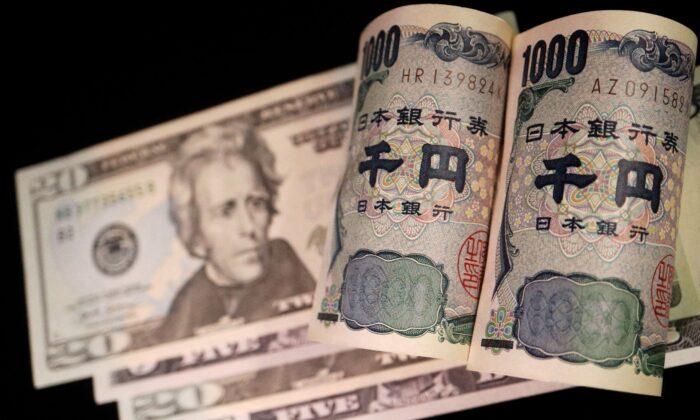LONDON/TOKYO—The dollar touched its highest in over a week against the yen on Wednesday, boosted by a jump in Treasury yields and by anticipation among investors of a rebound in Chinese growth as COVID-19 curbs loosen.
The yen also came under pressure after the Bank of Japan signaled that a surprise policy shift last week did not mark the start of a broader withdrawal of monetary stimulus.
The dollar rallied by as much as 0.67 percent to 134.40 in Asian trading, the most since Dec. 20, when the BOJ sent the pair spiralling lower with an unexpected loosening of the 10-year Japanese government bond yield policy band.
That day, the yen staged its biggest one-day rally against the dollar in 24 years, closing 3.8 percent higher on the day, as traders speculated about an eventual unwinding of stimulus.
A summary of opinions from the meeting though, released Wednesday, showed policymakers backing a continuation of ultra-accommodative policy, even as they discussed growing prospects the country could see higher wage growth and sustained inflation next year.
“It basically confirmed that the BOJ surprise from last week was a one-off, but from a longer-term viewpoint nobody believes it,” said Osamu Takashima, head of G10 FX strategy at Citigroup Global Markets Japan, who expects dollar-yen to fall through 130 in the second half of next year.
“But in the near term, dollar-yen is bouncing back,” he said. “Now, the market is expecting a solid recovery in the Chinese economy,” and those hopes have strongly lifted bond yields, buoying dollar-yen, he added.
The 10-year Treasury yield, which tends to have a high correlation with the dollar-yen pair, was at 3.8316 percent, down 3 basis points, having hit a six-week high of 3.862 percent the previous day.
Throwing a spanner into the works for markets in the final weeks of the year is China’s rapid dismantling of its strict zero-COVID policies, which have severely hampered its economy for nearly three years.
Investors are faced with having to reconcile the pickup in economic activity as China’s consumers and businesses return to some kind of normality, with the impact of a surge in infections on the recovery.
“With infection levels running at many thousands per day, it’s little wonder that China’s COVID response should top many analysts’ list of concerns about 2023,” David Cottle, an analyst at DailyFX, said.
The dollar index, which measures the greenback against six major currencies, rose 0.1 percent to 104.31. It hit a six-month low of 103.44 two weeks ago when the Federal Reserve slowed interest rate hikes to a half-point pace.
Fed officials including Chair Jerome Powell though have stressed since then that policy tightening will be prolonged, with a higher terminal rate, fueling worries of a U.S. slowdown.
“The dollar is in a very interesting situation,” said Bart Wakabayashi, a branch manager at State Street in Tokyo.
“If we have a recession in the U.S., the Fed will have to cut rates, and obviously you will want to sell the dollar,” he said. “At the same time, if there’s a global recession, people will buy the dollar as a haven. So the dollar is in a bit of a conundrum, and you have to be really careful what currency you’re buying or selling against.”
The euro was flat at $1.0637, having traded steadily around six-month highs for the past couple of weeks, since European Central Bank President Christine Lagarde stressed rate hikes would need to continue.
Sterling held at $1.2028 against the dollar and was steady against the euro at 88.45 pence.
The Australian dollar rose 0.4 percent to 0.07 percent to $0.6758, while the New Zealand dollar rose 0.41 percent to $0.6299.





